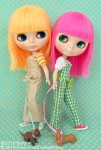Blythe /ˈblaɪθ/ is a fashion doll, about 28 cm (11 inch) tall, with an oversized head and large eyes that change color with the pull of a string. It was created in 1972 and was initially only sold for one year in the USA by toy company Kenner (later purchased by Hasbro). In 2000 the photo book This is Blythe was published and in 2001 the Japanese toy company Takara[nb 1] began producing new editions of Blythe dolls. There is a network of hobbyists who customize the doll for resale and create clothing and shoes for Blythe. Enthusiasts share photographs of their work and other types of dolls on the Internet.[1]
History
Blythe was created in 1972 by designer Allison Katzman at Marvin Glass and Associates[2] and marketed in the USA by the now-defunct toy company Kenner. Due to a lack of interest, Blythe dolls were only sold for one year in the U.S. (produced in Hong Kong) and also in Australia and Japan, during 1972. It would only become popular some 27 years later. Reportedly, she was modeled after drawings by Margaret Keane, similarly to many other dolls of the '60s and '70s. Her most distinctive feature were eyes that changed color with the pull of a string attached to the back of her head.
In mid-1991, Hasbro purchased Tonka, which acquired Kenner Parker Toys, Inc. in 1987. Since then, all the intellectual properties were transferred to Hasbro.
In 1997, New York TV and video producer Gina Garan was given a 1972 Kenner Blythe by a friend and began using it to practice her photographic skills. She began taking her Blythe everywhere with her and took hundreds of photos. In 1999, she was introduced to CWC's Junko Wong by artist and illustrator, Jeffrey Fulvimari which brought Blythe to the attention of Parco and toy executives. In 2000, Gina published her first book of Blythe photography with Chronicle Books, This is Blythe. In 2001, Hasbro (the current trademark and license owner) gave Takara[nb 1] of Japan and CWC a license to produce the New Edition of Blythe (Neo Blythe). Blythe was used in a television advertising campaign by Parco, the fashion branch of Seibu Department Stores in Japan and was an instant hit.
In 2003 Blythe was the subject in a segment on the VH1 special, I Love the 70s, where she was said to look like either "Barbie with elephantiasis" or "Christina Ricci" among other things. The success in Japan led Hasbro to issue a license to Ashton-Drake Galleries in 2004 to sell Blythe replica dolls in the United States, where the doll became a niche product in a marginal market, selling largely to adults. In spring 2009, Alexander McQueen launched a fashion line for Target with an ad campaign featuring Blythe dolls.[3] In 2010, Hasbro began releasing their version of Blythe as a part of Littlest Pet Shop toy line.
source from wikipedia
